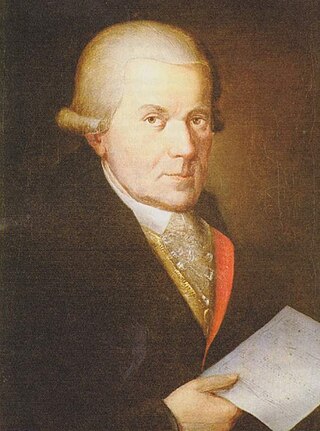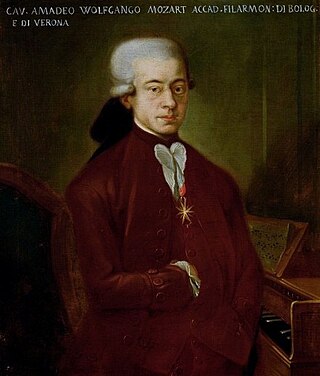In music, the opus number is the "work number" that is assigned to a musical composition, or to a set of compositions, to indicate the chronological order of the composer's publication of that work. Opus numbers are used to distinguish among compositions with similar titles; the word is abbreviated as "Op." for a single work, or "Opp." when referring to more than one work. Opus numbers do not necessarily indicate chronological order of composition. For example, posthumous publications of a composer's juvenilia are often numbered after other works, even though they may be some of the composer's first completed works.

Johann Michael Haydn was an Austrian composer of the Classical period, the younger brother of Joseph Haydn.

Otto Jahn, was a German archaeologist, philologist, and writer on art and music.

Johann Joseph Fux was an Austrian composer, music theorist and pedagogue of the late Baroque era. His most enduring work is not a musical composition but his treatise on counterpoint, Gradus ad Parnassum, which has become the single most influential book on the Palestrinian style of Renaissance polyphony.

The Köchel catalogue is a chronological catalogue of compositions by Wolfgang Amadeus Mozart, originally created by Ludwig Ritter von Köchel, in which the entries are abbreviated K. or KV. Its numbers reflect the ongoing task of compiling the chronology of Mozart's works, and provide a shorthand reference to the compositions.

Ignaz Xaver Ritter von Seyfried was an Austrian musician, conductor and composer. He was born and died in Vienna. According to a statement in his handwritten memoirs he was a pupil of both Wolfgang Amadeus Mozart and Johann Georg Albrechtsberger. He edited Albrechtsberger's complete written works after his death, published by Tobias Haslinger. His own pupils included Franz von Suppé, Heinrich Wilhelm Ernst, Antonio Casimir Cartellieri, Joseph Fischhof and Eduard Marxsen who would later teach Brahms.

The Piano Concerto No. 27 in B♭ major, K. 595, is Wolfgang Amadeus Mozart's last piano concerto; it was first performed early in 1791, the year of his death.

The Alte Mozart-Ausgabe is the name by which the first complete edition of the music of Wolfgang Amadeus Mozart, is known. It was published by Breitkopf & Härtel from January 1877 to December 1883, with supplements published until 1910. The name Alte Mozart-Ausgabe is actually a modern invention to distinguish the edition from the second Mozart complete works edition, the Neue Mozart-Ausgabe; the publication title of Breitkopf & Härtel's edition was Wolfgang Amadeus Mozarts Werke. Kritisch durchgesehene Gesammtausgabe.

Piano Concerto No. 5 in D major, K. 175, was composed by Wolfgang Amadeus Mozart in 1773 at the age of 17. It is Mozart's first original piano concerto; his previous efforts were based on works by other composers. In 1782, he revised the score and composed a new rondo, adding a flute to the instrumentation.
Ritter is the second lowest-ranking title of nobility in German-speaking areas, just above an Edler, considered roughly equal to the title Knight or Baronet.

The Missa brevis in G major, K. 140, K3 Anh. 235d, K6 Anh. C 1.12, was probably composed by Wolfgang Amadeus Mozart shortly after returning to Salzburg, in March 1773, from his third trip to Italy.

The Sinfonia Concertante for Four Winds in E-flat major, K. 297b, is a work thought to be by Wolfgang Amadeus Mozart for oboe, clarinet, horn, bassoon, and orchestra. He originally wrote a work for flute, oboe, horn, bassoon, and orchestra, K. Anh. 9 (297B), in Paris in April 1778. This original work is lost.
The Symphony "No. 43" in F major, K. 76/42a, was probably written by Wolfgang Amadeus Mozart.
The Symphony in F major "No. 56", K. 98/Anh.C 11.04, was once thought to have been written by Wolfgang Amadeus Mozart, but today is regarded as spurious. As of 2009, it is the only one of Mozart's symphonies published in the Alte Mozart-Ausgabe that has never been recorded. It is not included in the Neue Mozart-Ausgabe.

The Symphony in A minor "Odense", K. Anh. 220/16a, was formerly attributed to Wolfgang Amadeus Mozart. If the Odense Symphony had truly been Mozart's, it would be among only three of Mozart's symphonies to be written in a minor key. It is now considered certain that the symphony is not by Mozart.
This article gives an overview of various catalogues of classical compositions that have come into general use.











